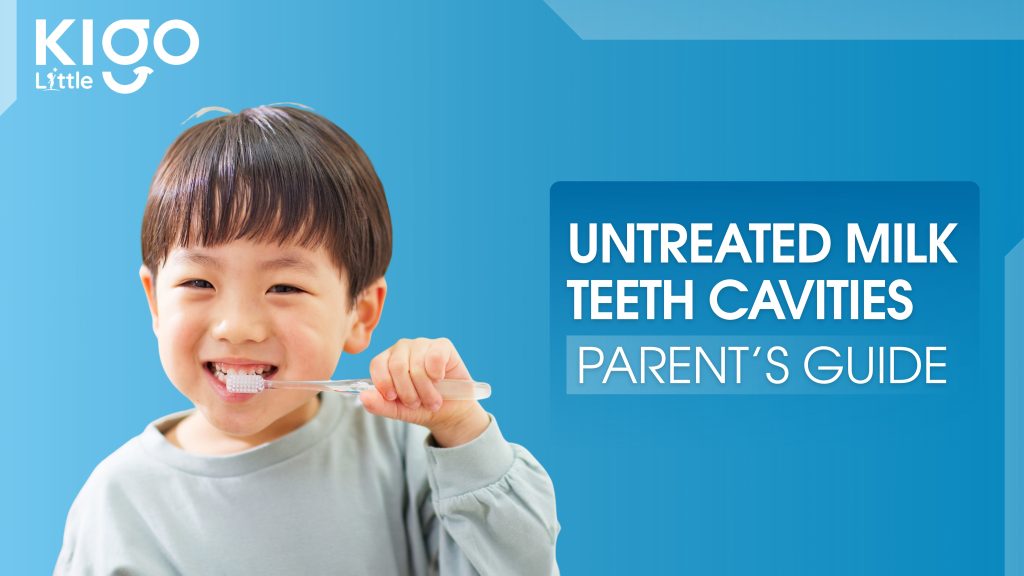As parents, it’s easy to think, “They’re just baby teeth, they’ll fall out anyway.” Many moms and dads assume cavities in milk teeth don’t need much attention. But the truth is, ignoring cavities in children’s primary teeth can lead to serious problems—not only for the tooth itself but also for your child’s long-term dental health, growth, and even confidence.
Let’s break down why treating milk teeth cavities on time is so important, the hidden risks of leaving them untreated, and what you can do to keep your child’s smile healthy.

Why Milk Teeth Matter
Baby teeth (also called primary or milk teeth) serve more purposes than just helping children chew. They:
- Maintain proper spacing for permanent teeth
- Guide adult teeth into the right position
- Help children speak clearly
- Build confidence with a healthy smile
When cavities develop in these teeth and aren’t treated, the problems can snowball.
Risks of Untreated Cavities in Milk Teeth
1. Severe Tooth Pain
Children may not always explain their discomfort clearly, but untreated cavities can cause intense pain, making it hard to eat, sleep, or concentrate in school.
2. Infections and Swelling
If cavities spread deeper, bacteria can reach the tooth pulp, causing abscesses (pus-filled infections). These can lead to swelling of the gums, cheeks, and even the jaw. In rare cases, untreated infections may spread to other parts of the body.
3. Damage to Permanent Teeth
Cavities in milk teeth can directly affect the developing permanent teeth beneath them. Infections can cause enamel defects, weak spots, or discolouration in the adult teeth that grow later.
4. Early Loss of Baby Teeth
Untreated cavities often result in premature extraction. Losing a tooth too early can cause neighbouring teeth to shift, leading to crooked permanent teeth and orthodontic problems later.
5. Difficulty Eating and Malnutrition
Painful teeth make kids avoid certain foods, especially healthy ones like fruits, nuts, and vegetables. Over time, this can affect growth and nutrition.
6. Speech Problems
Baby teeth support clear pronunciation. Missing or decayed teeth may make it harder for kids to speak properly, impacting communication skills.
7. Emotional Impact
Visible cavities, dark spots, or missing teeth can affect a child’s self-esteem. They may avoid smiling, talking, or interacting with peers.
How to Recognize Cavities in Kids Early
Parents should look out for:
- White spots or chalky areas on teeth (early decay)
- Brown or black discoloration
- Sensitivity to hot, cold, or sweet foods
- Persistent bad breath
- Complaints of toothache or chewing discomfort
- Swelling or redness near gums
If you notice these, it’s time to schedule a dental check-up.
Treatment Options for Milk Teeth Cavities
The treatment depends on the severity of decay:
- Fluoride Treatment: For early cavities, fluoride varnish can help re-mineralize teeth.
- Fillings: For mild to moderate cavities, tooth-colored fillings restore function and stop decay from spreading.
- Pulp Therapy (Pulpotomy/Pulpectomy): If decay reaches the nerve, pediatric root canal treatments are performed to save the tooth.
- Crowns (Caps): Stainless steel or tooth-colored crowns protect weak or treated teeth from further damage.
- Extraction: If the tooth is too damaged to save, extraction may be necessary, sometimes followed by a space maintainer to preserve alignment for adult teeth.
Preventing Cavities in Milk Teeth
Prevention is always better than cure. Here are simple steps every parent can take:
- Start brushing with a soft brush as soon as the first tooth appears.
- Use a pea-sized amount of fluoride toothpaste after age 3.
- Teach kids to brush twice daily and floss once a day.
- Limit sugary snacks, juices, and sticky foods.
- Encourage water instead of sodas or packaged drinks.
- Schedule dental check-ups every 6 months.
- Consider fluoride varnish or sealants if recommended by your dentist.
Milk teeth may be temporary, but their health has lifelong effects. Untreated cavities don’t just cause pain—they risk infections, misaligned adult teeth, and even confidence issues for your child. By treating cavities early and prioritizing preventive dental care, you’re setting up your child for healthier permanent teeth and a brighter smile.
At Kigo Little, we know your child’s smile means the world to you. That’s why we make dental visits gentle, fun, and stress-free while protecting those precious milk teeth from cavities. Call us at 📞 +91 8333999987 today to book a check-up and give your little one the gift of a healthy, happy smile.
FAQs
Q: Should cavities in baby teeth really be treated if they’ll fall out anyway?
A: Yes. Baby teeth hold space for permanent teeth, help in chewing, and prevent infections that could affect adult teeth.
Q: Can cavities heal on their own in kids?
A: No. Once enamel breaks down, cavities progress. Only professional treatment can stop or reverse early decay.
Q: What if my child is scared of dental treatment?
A: Pediatric dentists are trained to handle children gently, using friendly language, distraction, and sometimes sedation if needed.
Q: Are fillings safe for children?
A: Yes. Tooth-colored materials are biocompatible and safe for pediatric use.
Q: How often should kids see a dentist?
A: Twice a year for preventive check-ups, or sooner if you notice pain, swelling, or spots on teeth.
Q: What happens if a baby tooth is extracted too early?
A: A space maintainer may be used to ensure permanent teeth grow in properly. Without it, teeth may drift and cause crowding.





